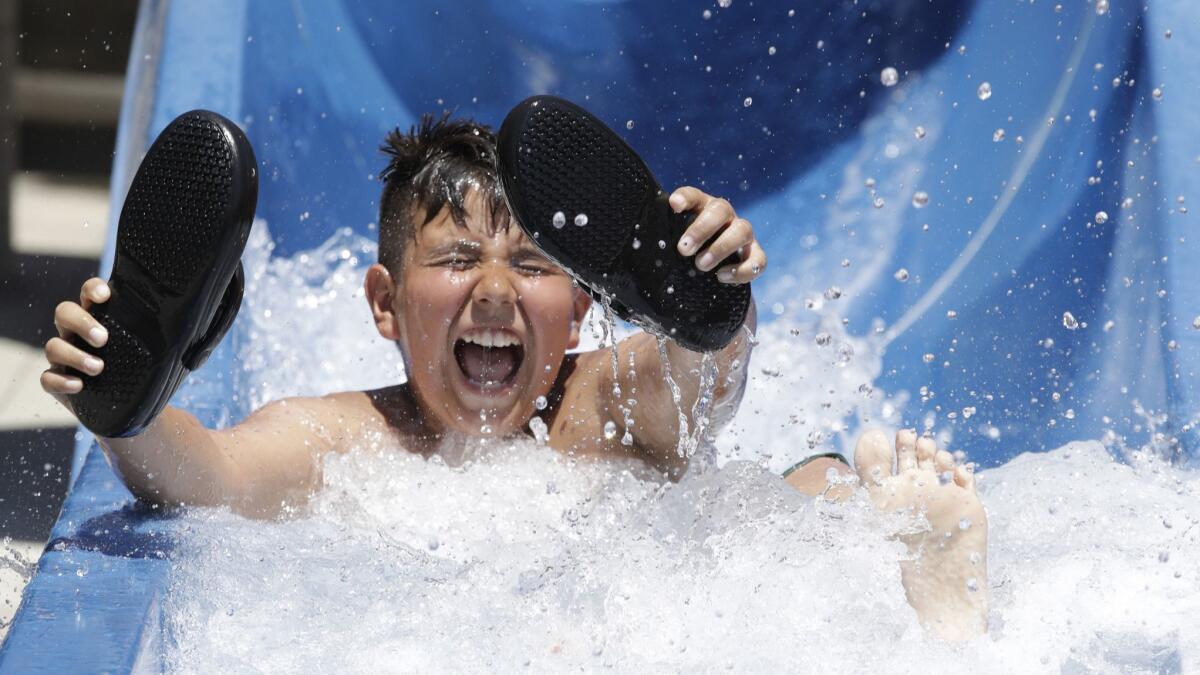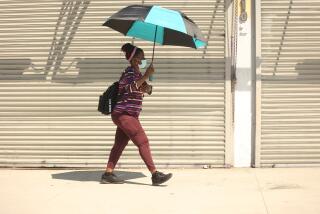How to keep children, seniors, pets — and yourself — cool this summer

- Share via
When you bear the burden of living somewhere that’s constantly warm and sunny, it’s easy to forget one simple fact: You still need to shield yourself from high temperatures and strong ultraviolet rays. Brush up on heat-wave safety with these 15 tips about how to protect yourself, children, seniors and pets from summer’s dangerously high temperatures:
For people
1. Stay indoors during the hottest hours
Avoid being outside between 10 a.m. and 3 p.m., when the sun’s burning rays are strongest. Use this as an excuse to hang out in air-conditioned zones, such as museums, movie theaters, malls or one of Los Angeles County’s 100+ cooling centers.
2. Do consume…
Plenty of fluids. The County of Los Angeles Emergency Survival Program recommends drinking two to four glasses of water every hour during the hottest hours (unless your doctor says otherwise). If you’re exercising, working outside or just sweating more than usual, drink low-sugar fruit juices and sports drinks to replenish your body’s salts and minerals.
3. Don’t consume…
Hot, heavy meals. And you might want to go easy on alcohol and caffeine. Why? The Centers for Disease Control and Prevention says alcohol and caffeinated beverages will make you lose fluids, while a big bowl of stew will only make you feel hotter.
4. Never leave a human in a hot car
This goes for children, seniors and everyone in between. Even with cracked windows, cars can quickly heat up, leading to risk of heat stroke or death, according to the CDC.
5. Dress for the weather
Wear lightweight, loose-fitting clothing that covers your arms and legs. Bonus points for light colors, which reflect sunlight, said Dr. Jeffrey Gunzenhauser, Interim Health Officer at the Los Angeles County Department of Public Health. To protect your face, wear a wide-brimmed hat.
6. Lather up
If you can’t avoid the sun, apply sunscreen with a SPF of at least 15. Give it 30 minutes to soak in before you go outside, and read the package’s directions so you know when to reapply.
7. Take it easy
Now’s not the best time to take up outdoor circuit training. Choose a lighter exercise routine, try to work out in a cool place, or exercise in the early morning, before the heat picks up. If you have to exert yourself outdoors, Gunzenhauser suggests taking a 15-minute break and drinking a quart of water every hour.
8. Know the signs
Familiarize yourself with the signs of heat-related illness. Here’s what the county’s Emergency Survival Program says you need to know:
Symptoms of heat cramps, related to dehydration, include increased sweating and painful muscle spasms in the arms, legs and abdomen. Move victims of heat cramps to a cooler setting, and gently massage afflicted areas to relieve spasms.
You may have heat exhaustion if you have symptoms such as weakness, fatigue, dizziness, nausea, vomiting and skin that is cold, clammy, pale, red or flushed. Victims of heat exhaustion should lie down in a cooler area with cold compresses.
Signs of heatstroke include headaches, nausea, vomiting, confusion and, when severe, delirium or unconsciousness. Skin will be hot, dry, red or flushed. If you see anyone with these symptoms, call 911 immediately.
9. Check on those at high risk
Groups at high risk of heat-related illness or death include infants, young children and those 65 and older, according to the CDC. People who are already physically ill, especially with heart disease or high blood pressure, and those who take certain medications for depression, insomnia or poor circulation are also at a higher risk. Know someone who fits this bill? Check in on them when temperatures soar.
For pets
10. Less time outside
The best way to keep your pet safe is to keep it in a shady, air-conditioned room as much as possible, said Dr. Karen Ehnert, director of Veterinary Public Health at the Los Angeles County Department of Public Health.
11. No alone time in a hot car
Remember that pets, just like humans, are at a high risk of heat stroke or death when left in a car when temperatures are on the rise. Just don’t do it.
12. Protect their paws
Before walking your dog, check the temperature of the asphalt and pavement. If it’s too hot for the back of your hand, or your own bare feet, it’s too hot for your dog’s vulnerable foot pads. Walk your dog during cooler times of the day to avoid blistered paws, Ehnert suggests.
13. Choose a suitable haircut
Shaggy fur may not look like the coolest coat, but it helps protect your pet’s skin from the sun. You can give your pet a trim, but don’t shave it down to the skin, Ehnert said.
14. Water, water, water
There’s no need to feed your pet differently during a heat wave, unless advised by your veterinarian. “Changing your pet’s diet abruptly can sometimes cause vomiting or diarrhea, which can increase the risk of dehydration,” Ehnert said.
“The most important step is to make sure cool, fresh water is available at all times.” Keep an eye on your pet’s water bowl to make sure they’re drinking enough. Better yet, put out two bowls, so they never run dry.
15. Watch for signs of heat illness
Heavy panting, lethargy and weakness are among the critical signs of heat stroke in animals, she said. If your pet becomes non-responsive, contact a veterinarian.






